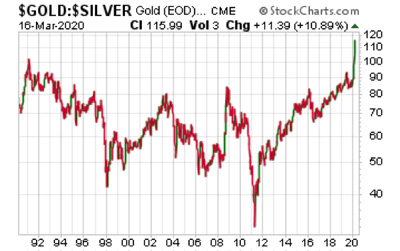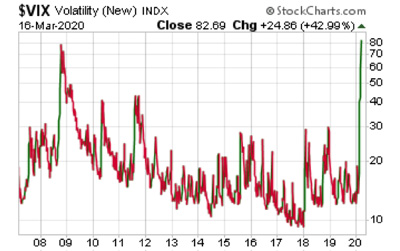-- Published: Wednesday, 18 March 2020 | Print | Disqus
Stefan Gleason, Money Metals
The last few days have been like nothing most of us have ever experienced Ė or are likely to experience again in our lifetimes.
Panic has spread from the streets of Wuhan to the grocery stores of Americaís heartland, from nursing homes to the Federal Reserve Board, from the stock market to the gold and silver markets.
Like other asset classes, the precious metals space is being rocked by rapidly accelerating developments, some of which havenít occurred for decades and some of which havenít occurred ever.
These unprecedented times are testing the mettle of precious metals investors like never before.
Gold and silver are meant to provide safe haven from financial turmoil. Safe haven demand for physical bullion has indeed surged. The pace of buying has been so furious in recent days that some dealers are literally running out of product to sell, and the scarcity has driven premiums are sharply higher.
So why havenít gold prices skyrocketed? For one thing, the bullion market is relatively small compared to the highly leveraged futures market that sets spot prices. Gold can get pulled down on any given day for no other reason than panicked traders need to sell it in order to raise cash.
When comparing gold to other assets, however, the monetary metal is performing exactly as it should during a time of crisis. Gold has risen strongly when measured against a crashing stock market over the past few weeks. It has spiked to multi-decade highs versus both crude oil and silver.
The gold:silver ratio has now entered previously uncharted territory. On Monday it spiked to 116:1. Put another way, a single ounce of gold could buy a staggering 116 ounces of silver.

Never has silver been as cheap to acquire in real terms as it is today. Never has the silver market traded so wildly disconnected from its fundamentals. Never have the silver bullion and silver futures markets diverged so greatly.
Whereas shortages and premium spikes are taking hold in American Eagles and other popular silver bullion products, the opposite is occurring on the exchanges. For example, one exchange-traded silver vehicle, Sprott Physical Silver Trust (PSLV), briefly traded down to a record 10% discount to its own net asset value.
On Monday, another inexplicable trading anomaly occurred. On a day when the general stock market suffered a 13% nosedive, the Silver Miners ETF (SIL) surged higher by 13% -- and it's surged again today. Yet spot silver prices had plunged by 12% at the same time.
If silver is down double digits and the equity market is also down double digits, how in the world do silver mining equities rise by double digits?
It makes no sense, unless the markets are completely broken and totally arbitrary at this point. Or unless big money counterintuitively flowed into the mining sector because the silver spot price has lost credibility.
Perhaps mining stock investors believe the actual physical silver market is already beginning to dictate higher prices (as reflected in surging premiums for silver coins) than what are being quoted in the paper market.
Perhaps we just witnessed a capitulation bottom in silver and at least a temporary peak in investor fear more broadly. The VIX volatility index, also known as the fear index for the stock market, spiked on Monday to exceed the fear levels registered during the depths of the financial crisis in 2008.

When markets are driven by extreme fear, they donít produce rational outcomes.
Strange, anomalous, and unprecedented price action in certain assets creates once-in-a-lifetime opportunities to profit as investors calm down and come to their senses. For example, you may never again get an opportunity to buy silver at less than 1/100th of the quoted gold price.
Unfortunately, itís difficult to obtain physical silver at all during moments like these. Bargain hunters have cleared out coin dealers of most of their inventories.
The upshot is that a new uptrend in silver, and a corresponding narrowing of the gold:silver ratio, can be expected to extend for years. You should have plenty of opportunities to buy on the way up before the metal becomes expensive.
There is no need to panic buy in fear of missing the bottom. We donít know whether it will be a ďVĒ-shaped bottom or one that drags out and gets re-tested again in the weeks ahead.
The current economic crisis is much broader in scope than previous crises centered on Wall Street and the banking system. The Fed canít fix it by cutting rates to zero and pumping more doses of Quantitative Easing into the bond market.
This is a Main Street crisis triggered by an invisible killer that will claim many more victims. President Trump and his top medical advisors now fully expect the number of infections to grow and the strain on the medical system to get worse before it gets better.
Will the carnage on Wall Street and in metals markets get worse, too? Nobody knows for sure. Nobody could have foreseen that a black swan event like a global pandemic would trigger a near total shutdown of the economy.
What we do know is that every other panic selling event in recorded history has produced fantastic buying opportunities for investors who didnít lose their shirts or their minds. This one will likely be no different.
Stefan Gleason is President of Money Metals Exchange, a precious metals dealer recently named "Best in the USA" by an independent global ratings group. A graduate of the University of Florida, Gleason is a seasoned business leader, investor, political strategist, and grassroots activist. Gleason has frequently appeared on national television networks such as CNN, FoxNews, and CNBC and in hundreds of publications such as the Wall Street Journal, The Street, and Seeking Alpha.
| Digg This Article
-- Published: Wednesday, 18 March 2020 | E-Mail | Print | Source: GoldSeek.com

